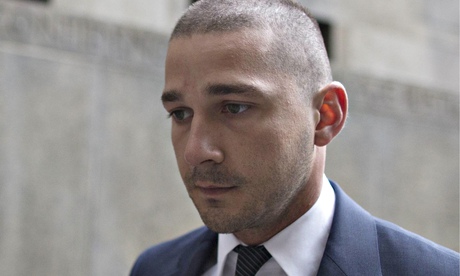
The actor Shia LaBeouf has told of being raped while performing his work #IAMSORRY at a Los Angeles art gallery. Was this a case of performance art creating an atmosphere in which anything, including crime, can happen?
Ever since the first ancestral performance happenings in the early 20th century, this dynamic and unpredictable form of art has been associated with violence and danger. From riotous Futurist evenings and the chaos of notorious avant-garde premieres such as that of The Rite of Spring in Paris in 1913, to surrealists insulting priests on the street, the moment when art becomes a kind of drama has often been a moment of physical threat.
LaBeouf’s performance #IAMSORRY is reminiscent of a more recent tradition of performance art that started in the early 1970s and replaces the sadism of the surrealists with a masochism in which the performer is a victim. In 1971, Chris Burden got himself shot in the arm in the name of art. He was also crucified on the back of a Volkswagen. Marina Abramović nearly died in a performance in which she was trapped in a burning, petrol-drenched star. Vito Acconci assumed the humiliating role of masturbating under the floor of an art gallery as he fantasised about the visitors above him.
Was a female visitor’s apparent assault on LaBeouf a grotesque misinterpretation of the myths of self-exposure and suffering that surround performance art?
Regardless of that incident, #IAMSORRY stinks of bad art. It shows how hard it is to create good work in this strange and difficult genre. To work, a performance must create a genuinely special and intense atmosphere of intimacy and risk. LaBeouf’s show, in collaboration with artists Luke Turner and Nastja Säde Rönkkö sounds, to be honest, like a third-rate imitation of the works of Abramović or Yoko Ono, whose Cut Piece dramatises vulnerability perhaps more powerfully than any other. People queued to encounter LaBeouf in a gallery. Er, hasn’t that been done? This piece is highly reminiscent of Abramović’s event The Artist Is Present, at the Museum of Modern Art in New York.
Like Abramović, the actor sat behind a desk waiting for visitors to interact with him. The difference was that he had a bag over his head bearing the words “I am not famous any more.”
It is the charisma and mystique of an Abramović that enables her to make such a performance powerful rather than pointless. LaBeouf’s exhibit sounds more like the kind of poorly conceived and basically silly event that gets performance art a bad name. Real artists rarely wear bags on their heads.
Clearly this does not excuse rape.
Yet it does put into perspective the romantic myth of “suffering for art”. People suffer for art all the time. Unfortunately, the art is rarely worth it. Pain alone does not make you an artist.

